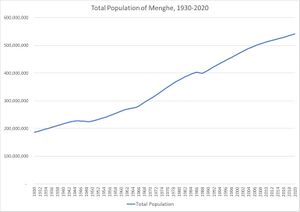Demographics of Menghe
This article is incomplete because it is pending further input from participants, or it is a work-in-progress by one author. Please comment on this article's talk page to share your input, comments and questions. Note: To contribute to this article, you may need to seek help from the author(s) of this page. |
| Demographics of Menghe | |
|---|---|
 Population of Menghe from 1930 to 2020 | |
| Population | |
| Growth rate | |
| Birth rate | 12.97 per 1,000 (2020) |
| Life expectancy | |
| • male | |
| • female | |
| Fertility rate | 1.78 children per woman (2020) |
| Infant mortality rate | 5.72 deaths per 1000 live births (2020) |
| Age structure | |
| 0–14 years | 18.59% (2020) |
| 15–64 years | 70.55% (2020) |
| 65 and over | 10.86% (2020) |
| Sex ratio | |
| At birth | 1.06 male to female (2020) |
| Under 15 | 1.06 male to female (2020) |
| 15–64 years | 1.05 male to female (2020) |
| 65 and over | 0.87 male to female (2020) |
| Nationality | |
| Nationality | noun: Menghean adjective: Menghean |
| Major ethnic | Meng |
| Minor ethnic | Lac, Argentans, Daryz, Kungnai, Dzhungars, Ketchvans |
| Language | |
| Official | Standard Menghean |
According to the 2020 Census, conducted on January 1st, Menghe had a population of 541,935,096 people, making it the second most populous country in Septentrion. The total fertility rate was 1.78 during the preceding year, below the natural replacement level of 2.1, though the population grew 1.24% due to declining mortality for higher age groups. Though the population is projected to continue growing for the next decade, the government has expressed concerns about the looming strains presented by an aging society.
Population
Historical population data
Events impacting demographics
For most of the 20th century, Menghe's natural rate of population change has been consistent with a high rate of population growth, as industrialization lowered infant mortality rates and allowed more children to reach childbearing age. In 1930, for instance, the total fertility rate was estimated at 5.2 births per woman, and annual population growth at 1.36%. Events during the 20th century, however, had a dramatic impact on Menghe's population growth, and during three periods the country experienced sustained negative population growth.
The first demographic shock was the Pan-Septentrion War. Over the course of thirteen years between 1932 and 1935, Menghe lost an estimated 3,437,000 military personnel, along with over 1.7 million civilian casualties, mainly from strategic bombing. Though census data for this period are spotty, independent estimates suggest that in 1945 Menghe experienced its first net population decline since the country's unification.
Negative population growth continued through the mid-to-late 1940s, as the Pan-Septentrion War carried over into the early stages of the Menghean War of Liberation. Allied estimates record some 300,000 military casualties in 1946, more than Menghe sustained in 1940, and 100,000 more in 1947. Civilian casualties also remained high during this period, due to the controversial Order 516 which resumed strategic bombing of population centers. On top of this, damaged infrastructure, chaotic administration, and an El Niño drought combined to produce a severe famine that may have left 3 million people dead. In tandem, baseline mortality figures returned to their 1930 levels, as forced de-urbanization and wartime damage to medical infrastructure left millions of people without adequate medical care.
Another wave of high mortality coincided with the final phase of the War of Liberation, as the Menghean Liberation Army massed its guerillas into a conventional force and pushed southward across the country. On top of some 1.77 million war dead, large numbers of civilians either perished in the crossfire or fled the country, fearing retribution by Communist-Nationalist forces. After the war's end in 1964, however, Menghe experienced a large baby boom as soldiers returned home and families settled into a long-awaited period of stability. The total fertility rate peaked at 5.48 in 1966 and remained above 4 until the early 1980s. In tandem with rising life expectancy, which improved welfare and rural medical care under the Communist government, this trend led to a period of high population growth.
The last major shock came in the late 1980s, as Ryŏ Ho-jun's government upended the previous period of stability under Sim Jin-hwan. The Menghean famine of 1985-87 brought population growth to a halt, even leading to a slight population decline in 1987. The official estimate, as recognized by the Menghean Socialist Party, places the death toll from the Ryŏ Ho-jun famine at 24.6 million, or 6.5% of the total population at the time. Independent studies suggest that the 24.6 million count is likely an overestimate, as it does not distinguish between infant deaths and foregone births, though the impact of the famine years on Menghe's population pyramid is nevertheless sharply visible.
After the famine's end, Menghe experienced a second, smaller "baby boom," with total fertility rates averaging 2.68 between 1988 and 1998. Some scholars argue that this boom had a major impact on Menghe's sustained economic development in the late 2010s, as the post-famine generation reached working age. From 1990 onward, fertility rates continued to decline, eventually falling below replacement levels. Life expectancy, however, has continued to climb, with reductions in mortality rate at every age.